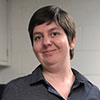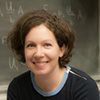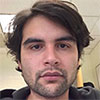Research
Faculty Research

Monica Olvera de la Cruz
- Elastic Shells
- Elastic Driven Self Assembly
- Electrostatics at Liquid Interfaces
- Ionic Gels
- Co-assembly of Biological and Synthetic Molecules
- Statistics, Thermodynamics and Dynamics of Complex Molecular Fluids
- Atomistic Modeling

Michael Bedzyk
- Semiconductor and metal-oxide surface structures
- Liquid/solid interface
- X-ray probes for Ultra-thin-films and Nanostructures
- Nanoscale Structures
- In Situ X-ray Synchrotron
- Molecular self-assembly

Michelle Driscoll
Michelle is a soft condensed matter experimentalist, and her research lies at the interface between soft-matter physics and fluid dynamics. Her lab focuses on understanding how structure and patterns emerge in a driven system, and how to use this structure formation as a new way to probe nonequilibrium systems. She studies emergent structures in a diverse array of driven systems, from the microscopic (driven colloidal suspensions) to the more table-top (fracturing meta-materials). By developing a deeper understanding of patterns and structures which emerge dynamically in a driven material, we can learn not only how these structures can be controlled, but also how to use them to connect macroscopic behavior to microscopic properties.

Erik Luijten
- Colloidal systems
- Electrostatically driven self-assembly
- Algorithm development
- Polymeric materials

Mani Madhav
- Model-driven measurement of forces in living epithelia
- Mechanical-feedback in morphogenesis
- Spatially patterned differentiation
- Transcriptional-advection and morphogenesis

John Marko
- The application of statistical mechanics and polymer physics to biophysical problems
- Micromechanical studies of DNA, DNA-protein interactions, and chromosome structure
- Experimental and theoretical research

Mark Ratner
- Electron transfer, electron transport, and electron dynamics
- Molecular assemblies, packing, and interactions
- Quantum Dynamics, and its relation to environmental baths and decoherence
- Organic devices, both single-molecule and adlayer-based
- Energy applications of several sorts

George Schatz
- Optical properties of nanoparticles and nanoparticle arrays and aggregates
- DNA structure, thermodynamics, and dynamics
- Self-assembly of soft materials
- Mechanical properties of nanomaterials
- Exciton formation, relaxation and thermal transport

Sam Stupp
- Self-Assembly
- Energy Materials
- Biomaterials

Igal Szleifer
- Biophysics of Lipids
- Biologically Inspired Nanomaterials
- Responsive Polymer Layers

Danielle Tullman-Ercek
CCTSM Catalyst Award Recipient- Determining rules for protein shell assembly
- Engineering protein shells for new geometries and functions
- Controlling transport across biological membranes
- Scaffolding inorganic nanostructures on biological templates
- Producing protein biomaterials with designed properties

Petia Vlahovska
Petia is an applied mathematician with interdisciplinary training in chemistry and engineering. Her research is in non-equilibrium soft condensed matter (emergent phenomena and self-organization in active matter, directed colloidal assembly, nonlinear microparticle dynamics, rheology of complex fluids), fluid dynamics (electrohydrodynamics and electrokinetics, fluid instabilities, interfacial flows, viscous flows) and membrane biophysics (biomembrane electromechanics, thermal shape fluctuations). Integrating theory and experiment, she explores the interrelation between the microscale physics, microstructure, and macroscopic behavior of soft materials out-of-equilibrium.
Research Associate/Postdoc Research

- Adsorption and Self-assembling of Macromolecules at Interfaces
- Wettability and Interfacial Phenomena
- Charge Adsorption and Energy Storage in Nanostructures
- Statistical Mechanics of Confined Complex Fluids
- Molecular Recognition
- Nucleation
- Molecular Engineering of Functional Molecules for Diverse Applications
- Interfaces and Mesophases in Soft Materials
I am collaborating in the group of Prof. Monica Olvera in modeling the adsorption and self-assembling of macromolecules at interfaces. My interests lie in scientific problems related to energy and environmental sustainability. My approach consists of gaining a fundamental understanding of the phenomena occurring at mesoscopic scales. New technologies can be designed by understanding how many-body forces work. I perform molecular engineering of systems using theoretical methods and molecular simulations. My past research focused on modeling charge adsorption and energy storage in nanostructures and self-assembling mechanisms. My recent work is on nucleation mechanisms of gas hydrates; molecular engineering of functional molecules for gas hydrates inhibition; self-assembling of surfactant nanostructures at liquid-solid interfaces; wettability and interfacial phenomena in oil-water-mineral substrate systems. My future research plan comprehends designing nanomaterials for efficient storage and transportation of energy, capture, and sequestration of greenhouse gases, and soft materials for diverse applications.

- Self-assembly systems
- Kinetics and transport phenomena in biological systems
- Molecular dynamics and electrostatics
As a member of Prof. Monica Olvera de la Cruz’s group, we primarily work in understanding the aggregation and formation of phase states of biological polymers such as DNA and proteins in a myriad of media. Depending upon the type of media, we can observe, by using simulations, the formation of membranes and other types of interesting collective behavior. It is in ensuing studies that we can test physical properties of interest of the aforementioned soft materials which can be applied in the pharmaceutical industry and others. Our approach to studying these complex systems relies on thermodynamics, statistical mechanics, and coarse-grained modeling.


